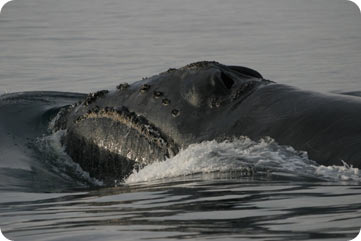Being right isn’t necessarily a good thing.
Consider a species of whale that once roamed the North Atlantic by the thousands. It’s slow, it swims close to shore, and it has a lot of blubber. These qualities made it the “right” whale for hunters, so it was called the right whale. But so many were caught that the species almost became extinct -- and could still.
 The right whale was hunted mostly for its blubber, used to make oil. Credit: National Oceanic & Atmospheric Administration
The right whale was hunted mostly for its blubber, used to make oil. Credit: National Oceanic & Atmospheric AdministrationHunters caught the whale for its “whalebone” -- a structure in the mouth that was used for corsets, dress hoops, and buggy whips. But mostly, they caught it for its blubber, which was boiled down to make oil.
Whale oil became a commercial product as early as the 11th Century. But it really caught on in the 18th and 19th Centuries, when hundreds of American ships pursued whales around the globe.
The oil was used to fuel lamps and to make candles. The candles didn’t smell very good, but they lasted longer and burned brighter than other candles. Whale oil was also used in soap, cosmetics, and many other products.
At first, whalers caught species that stuck close to shore, like the right whale. Later, though, they went after the sperm whale, which inhabits deep waters around the world. A cavity in the heads of these giants is filled with up to a couple of hundred gallons of a waxy substance known as spermaceti, which yields a higher-grade oil. Whaling ships would process both the spermaceti and blubber at sea, filling hundreds of barrels on each trip -- providing a fuel that may have been right for the time, but not for the whales.

